
I explore these patterns and describe them to another person, noticing the healing power of compassionate listening.
Discussion of Step 5:
Step 5 continues the process that started with Step 4. You are looking at behavior patterns, as opposed to just behaviors in isolation. In Step 4, you identified behavior patterns. Now, you are trying to understand them.
The vicious cycle
Before going any further, I want to address why it is essential to approach this process with self-compassion. That is, I want to talk about the pitfalls of self-criticism and the vicious cycle that ensues.
Here is how it goes. You do something that you would call a “wrong,” and you criticize yourself for it. You feel ashamed of yourself. Through willpower, you manage not to do it for a while. And then, you slip. You do it again. You feel ashamed. It’s so unpleasant that you end up indulging as a way to relieve the stress. The vicious cycle goes on, alternating between moments of willpower and moments of shame.
You have to step out of that cycle. For that, you need to understand what is happening and take action earlier.
Understanding the emotional logic
Trying to understand your behavior patterns means exploring why you do what you do. Is it just because you’re an evil, nasty person? Is it that you’re so lazy that you do things that hurt other people out of sheer laziness? Or is there some method behind the madness?
There is usually some logic behind what you do. It is emotional logic, not rational logic. You do your best to understand it, as opposed to judging it and forcefully eradicating it.
As you do, it is good to keep in mind the difference between condoning and understanding. Condoning would be trying to glorify the problematic patterns. Understanding helps you change.
How do you proceed with exploring this?
Here, I’m going to describe sub-steps of Step 5 to make the process clearer.
First, you’re going to get a general sense of the pattern. An impressionistic, fuzzy sense of what might be emotionally behind what you do. Why, for instance, you arrive late at your appointments. Or why you might be angry at certain people. You go beyond the self-blame, and you understand the reason behind it. And, probably, it’s something like fear. So now you have a general sense of it.
Then you stay with it with curiosity. You try to work it a little deeper. You don’t stop with that very vague sense of: “Oh, I’m doing it because it’s fear,” but you try to be a little bit more specific.
You stay with an example, a situation. You get a sense of what it felt like inside when you were in that situation, and you let the feelings come up. So it’s not just an abstract concept, like “Oh, it’s fear.” Now, you recapture the experience. For instance, you experience tense shoulders, a constricted chest, or shallow breathing again. Or, maybe, that something in your stomach?
As you are reliving the physical sensations that you had been experiencing, you also visualize the situation. It is as if you were watching a video of it. Now, you have a felt sense of what the situation was like, from inside and outside. It is a felt sense, not an abstraction. And so, you now have more of a handle on what is happening.
Compassionate listening
Now, find another person, a friend, to talk to about what happened. Talking to another person helps means that you need to find words to communicate the experience more clearly than when you are on your own. Your friend asks you questions, which also helps you find ways to capture better what happened. As a result, you gain more understanding of your behavior pattern.
What you gain is not just better conceptual understanding. You experience the healing power of compassionate listening. You have a sense of spaciousness and acceptance.
If you are worried that compassion and acceptance will only reinforce problematic behavior patterns, keep in mind that accepting does not mean condoning. Accepting what is gives you the capacity to change.
What does this have to do with God?
The original Step 5 of A.A. talks about “admitting to God.” Here again, it helps to think of this in context. For the people who wrote the Twelve Steps, the notion of redemption was intricately linked to the Christian religion. In the decades since they wrote the Twelve Steps, we have become more familiar with other ways to experience compassionate healing. In particular, we understand the healing power of compassionate listening. Ascribing it to God is optional.